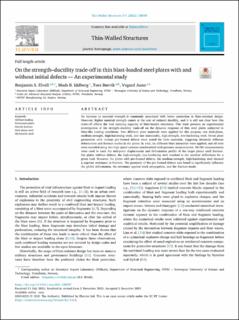| dc.contributor.author | Elveli, Benjamin Stavnar | |
| dc.contributor.author | Iddberg, Mads Bakken | |
| dc.contributor.author | Børvik, Tore | |
| dc.contributor.author | Aune, Vegard | |
| dc.date.accessioned | 2022-04-29T12:38:48Z | |
| dc.date.available | 2022-04-29T12:38:48Z | |
| dc.date.created | 2021-12-21T15:18:43Z | |
| dc.date.issued | 2022 | |
| dc.identifier.citation | Thin-walled structures. 2022, 171, 108787. | en_US |
| dc.identifier.issn | 0263-8231 | |
| dc.identifier.uri | https://hdl.handle.net/11250/2993437 | |
| dc.description.abstract | An increase in material strength is commonly associated with better protection in blast-resistant design. However, higher material strength comes at the cost of reduced ductility, and it is still not clear how this trade-off affects the load carrying capacity of blast-loaded structures. This work presents an experimental investigation of the strength–ductility trade-off on the dynamic response of thin steel plates subjected to blast-like loading conditions. Two different plate materials were applied for this purpose; one dual-phase, medium-strength, high-hardening steel, and one martensitic, high-strength, low-hardening steel. Seven plate geometries with various pre-formed defects were tested for both materials, triggering distinctly different deformation and fracture modes in the plates. In total, six different blast intensities were applied, and all tests were recorded using two high-speed cameras synchronized with pressure measurements. 3D-DIC measurements were used to track the mid-point displacement and deformation profile of the target plates until fracture. For plates without defects, the high-strength, low-hardening steel resulted in the smallest deflections for a given load. However, for plates with pre-formed defects, the medium-strength, high-hardening steel showed a superior resistance to fracture. The geometry of the pre-formed defects was found to significantly influence the global deformation, the resistance against crack propagation, and the fracture mode. | en_US |
| dc.language.iso | eng | en_US |
| dc.publisher | Elsevier | en_US |
| dc.relation.uri | https://www.sciencedirect.com/science/article/pii/S0263823121007667 | |
| dc.rights | Navngivelse 4.0 Internasjonal | * |
| dc.rights.uri | http://creativecommons.org/licenses/by/4.0/deed.no | * |
| dc.subject | Airblast loading | en_US |
| dc.subject | Perforated plates | en_US |
| dc.subject | Ductile fracture | en_US |
| dc.subject | Dual phase steel | en_US |
| dc.subject | Martensitic steel | en_US |
| dc.title | On the strength-ductility trade-off in thin blast-loaded steel plates with and without initial defects – An experimental study | en_US |
| dc.type | Peer reviewed | en_US |
| dc.type | Journal article | en_US |
| dc.description.version | publishedVersion | en_US |
| dc.rights.holder | © 2021 The Author(s). Published by Elsevier Ltd. This is an open access article under the CC BY license (http://creativecommons.org/licenses/by/4.0/). | en_US |
| dc.source.volume | 171 | en_US |
| dc.source.journal | Thin-walled structures | en_US |
| dc.identifier.doi | 10.1016/j.tws.2021.108787 | |
| dc.identifier.cristin | 1971133 | |
| dc.relation.project | Norges forskningsråd: 237885 | en_US |
| dc.source.articlenumber | 108787 | en_US |
| cristin.ispublished | true | |
| cristin.fulltext | original | |
| cristin.qualitycode | 1 | |

